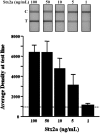Detection of shiga toxins by lateral flow assay
- PMID: 25855129
- PMCID: PMC4417961
- DOI: 10.3390/toxins7041163
Detection of shiga toxins by lateral flow assay
Abstract
Shiga toxin-producing Escherichia coli (STEC) produce shiga toxins (Stxs) that can cause human disease and death. The contamination of food products with STEC represents a food safety problem that necessitates rapid and effective detection strategies to mitigate risk. In this manuscript, we report the development of a colorimetric lateral flow assay (LFA) for the rapid detection of Stxs in <10 min using a pair of monoclonal antibodies that bind epitopes common to Stx1 and six Stx2 variants. This LFA provides a rapid and sensitive test for the detection of Stxs directly from STEC culture supernatants or at risk food samples with a 0.1 ng/mL limit of detection (LOD) for Stx2a. This Stx LFA is applicable for use in the rapid evaluation of Stx production from cultured E. coli strains or as a tool to augment current methods as part of food safety testing.
Figures





References
-
- Griffin P.M., Tauxe R.V. The epidemiology of infections caused by Escherichia coli O157:H7, other enterohemorrhagic E. coli, and the associated hemolytic uremic syndrome. Epidemiol. Rev. 1991;13:60–98. - PubMed
Publication types
MeSH terms
Substances
LinkOut - more resources
Full Text Sources
Other Literature Sources
Medical

